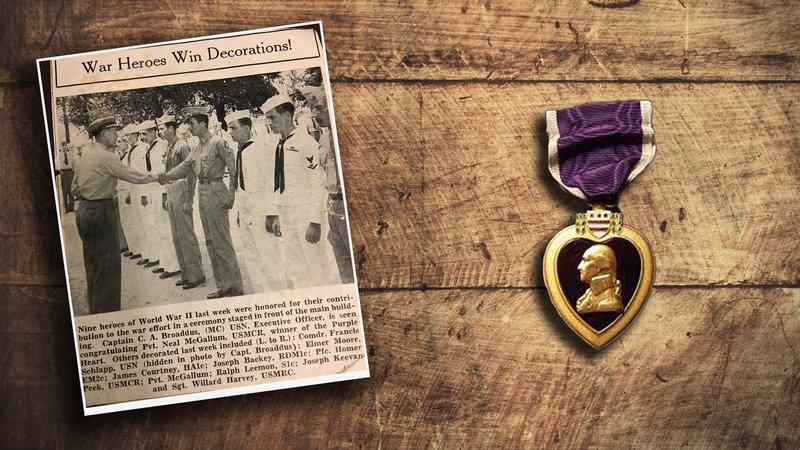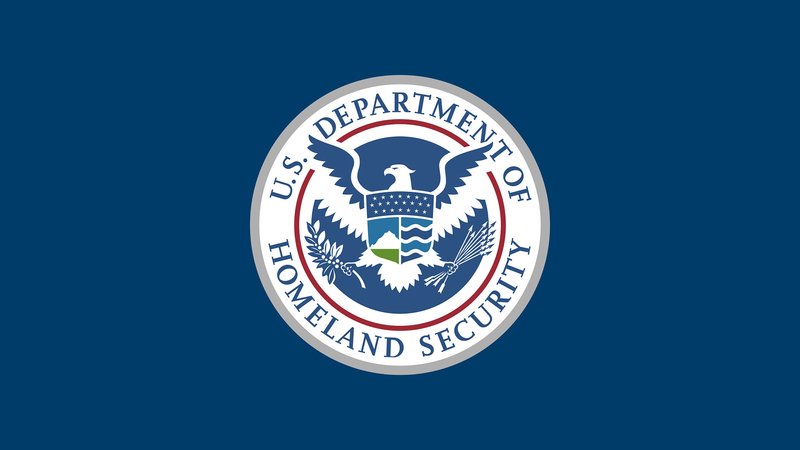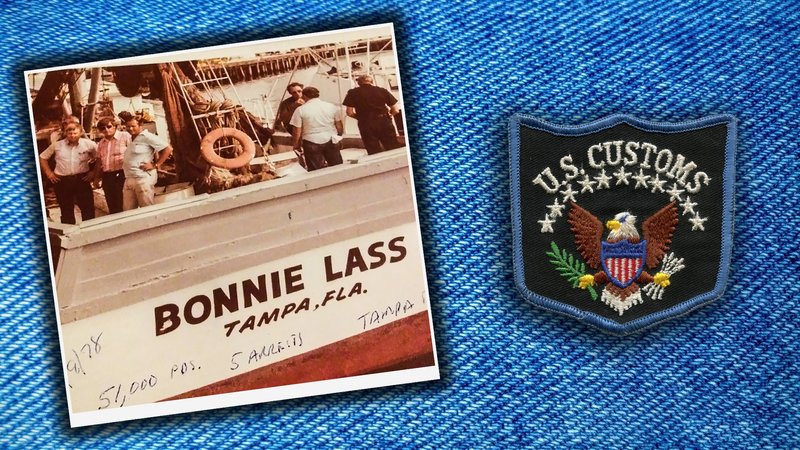From World War II to US Customs, Neal McCallum’s 46 Years Dedicated to Uncle Sam

Neal McCallum served with 6th Marine Division at Okinawa during World War II and later continued living a life of great adventure courtesy of Uncle Sam. Adobe stock photo and photo courtesy of Neal McCallum. Composite by Coffee or Die Magazine.
Neal McCallum once crossed the Atlantic Ocean alone in a small sailboat. The stakes were high then, but marginal compared with the undercover anti-smuggling assignment he volunteered for in the summer of 1974.
By the 1970s, Miami, Florida, held the reputation as the “marijuana capital of the world.” The billion-dollar illegal drug trade involved a mix of criminal personalities, from hardcore drug kingpins to CIA-trained Cuban exiles from the failed Bay of Pigs invasion to recreational anglers. All had a hand in the trafficking of thousands of pounds of contraband from Jamaica, the Cayman Islands, and Colombia into the southern tip of Florida. As a result, US Customs Service agents scrambled to crack down on the flow of drugs with anti-smuggling interdiction cases.
McCallum, a 47-year-old Marine veteran and criminal investigator of the US Customs Service, went undercover to infiltrate a gang in Pinellas County, Florida. To cripple its operations and shut down the international smuggling ring, however, McCallum had to go directly to the source: the gang’s base of Santa Marta, Colombia. The gang’s “Colombian bud” plantation reigned supreme in the busy port city.
McCallum, joined by two pre-screened parolees, rented a sailboat with enough compartment space to carry a significant load of dope. To help him maintain his cover, he acquired an off-the-books revolver from a colleague. Getting caught with a department-issued firearm could threaten future anti-smuggling cases in the region. McCallum also wore the standard disguise of contrabandistas he’d encountered in the past: shorts, sunglasses, and a short-sleeved shirt. If one were going to infiltrate a foreign country and surreptitiously meet a dope dealer without getting compromised, one had to look and act the part.

Neal McCallum pictured alongside eight other US service members receiving the Purple Heart medal in Virginia for wounds suffered during World War II. Notably, the newspaper clipping spelled McCallum's name wrong. Photo courtesy of Neal McCallum. Composite by Coffee or Die Magazine.
The team of three launched their sailboat from Clearwater, Florida, and sailed some 1,200 miles by way of the Windward Passage northeast of Cuba to reach Santa Marta’s harbor. For several days, the team motored nonstop against the current and prevailing winds. When they arrived at night, the gang’s scouts arranged a meeting on the water. Their leader — assuming McCallum was another experienced drug runner — volunteered to complete the maritime exchange. The gang loaded the prized Colombian bud into McCallum’s boat and a vessel of their own.
Having done similar exchanges hundreds of times before, the gang members didn’t suspect a mole in their midst. The two boats motored some four or five days at sea, and right before reaching Clearwater, McCallum contacted authorities, who clandestinely positioned arrest squads near the beach.
“About 2 miles off Clearwater Pass, the bad guys came around with their boat to unload the marijuana,” McCallum told The Forward Observer. “I’m on a VHF radio, a sequestered channel, talking to US Customs agents and a local sheriff on land. There had to be 50 different police agencies there to arrest this guy because he was a big target.”
The seizure confiscated about a ton of contraband and disrupted one of the boldest marijuana smuggling rings in the war on drugs. For all its danger, the mission didn’t rattle McCallum, who said he didn’t have much to fear after his experiences in combat during World War II.
Okinawa
McCallum was born on March 10, 1927, and raised on his family’s 28-acre pine forest farm in Candor, North Carolina. When he was only 14 years old, he took his horse to confront a group of men on the edge of their pasture in the woods. He found the men in fatigues huddled around an Army blanket, throwing dice. They were soldiers from the 29th Infantry Division training in the Carolina Maneuvers alongside soldiers from the 1st Infantry Division — the “Big Red One” — before they were shipped off to France to conduct the historic amphibious landings at Normandy.
McCallum’s four older brothers participated in the invasion of Normandy, arriving in France just after D-Day. His brother Allen S. McCallum was later killed in action in Germany. In 1944, at 17, McCallum followed his brothers into the military but was sent to Guadalcanal in the Pacific rather than to Europe. For seven months, he received arduous training as a mortarman with the 6th Marine Division to practice assaults in tandem with machine-gun teams and flamethrower operators before landing on Okinawa.
In the early morning hours of Easter Sunday, 1945, battleships and destroyers pounded the Japanese island with naval gunfire until daybreak. McCallum arrived on shore around 10 a.m. and helped capture Yontan Airfield.
“On the second, third, and fourth of April, big swarms of kamikazes came over [the island],” McCallum told TFO. “The Japanese called them ‘Floating Chrysanthemums.’ I have since read there can be up to 350 planes.”
"Before the Bonnie Lass could escape, McCallum’s team pulled their cigarette boat alongside and swarmed the disguised shrimp vessel. "
The Marines’ landing in Okinawa was largely uncontested. The real fight occured inland, including the isolated Battle of Sugar Loaf Hill. It was a brutal assault over mountainous terrain that lasted eight days. One night, while McCallum was hiding behind dead bodies for cover from artillery fire, he had a moment of reflection.
“I remember thinking that there had to be a better way to settle disputes than this,” he said.
In May — just as his unit was being relieved by fresh troops — McCallum was wounded by shrapnel.
“It was a 150mm shell,” McCallum said. “The Japanese took these guns off of navy ships and put them into the Shuri Castle cliffs, which was only one-and-two-tenths miles from where I was. By the way, where we were was the Japanese artillery practice range.”
McCallum survived the artillery attack and took a transport ship from Guam to San Francisco, and eventually Virginia to recover. In the years after the war, McCallum left the Marines, went to college, and began working for the government.
An Original Sky Marshal
In 1971, the World War II veteran entered federal law enforcement in a brand-new unit implemented under President Richard Nixon’s administration. In response to a series of plane hijackings, Nixon established international anti-piracy laws, and McCallum became one of the first sky marshals to enforce the new rules of the air. He flew domestic flights, working on board Delta Airlines 747s in teams of three. According to McCallum, the job was boring most of the time, except for one unruly passenger who made a run for the cockpit.

Neal McCallum was one of the very first sky marshals with homeland security. Wikimedia Commons photo.
“When you came on board, on your right hand were first-class seats and a staircase that led to the cockpit and the lounge,” McCallum said. “This area was off-limits. As we were taking off, a passenger ran up the stairs, and we ran up and tackled him to the ground.”
The passenger freaked out and nervously explained he had raced up the stairs to access the bathroom. Although the man was unarmed, a little embarrassed, and no longer a threat, the sky marshals still took every precaution on the off chance he was a hijacker attempting to take control of the plane. Between 1968 and 1972, “skyjackers” who wanted to fly to communist Cuba, or to be paid a ransom, or even to vent some rage, hijacked more than 130 airplanes, according to Wired.
Coinciding with the growing threat of hijackings was the arrival of the war on drugs, in which federal law enforcement agents cracked down on illegal marijuana smuggling and cocaine trafficking.
In the early 1930s, marijuana was considered a legal import — the major smuggling problems then revolved around Prohibition-era alcohol and drugs like opium and heroin. In 1931, contrabandista-turned-US Customs agent Al Scharff started a sort of rogue air brigade. The most famous arrest of the unit’s tenure involved agents chasing rumrunner and former World War I ace William Thomas Ponder 200 miles from the Mexican border to San Antonio, Texas. The landmark case marked “the first airplane seizure where both the government and the hunted craft were in the air,” according to US Customs and Border Protection.
Despite increased drama in the sky, the most frequented drug highways in Florida were still at sea. McCallum left the sky marshals in 1973 in pursuit of a more exciting career as a criminal investigator in Tampa, where he had a front-row seat to anti-smuggling operations until the late 1980s.
The Bonnie Lass Seizure
Four years after McCallum’s undercover assignment in Colombia, the criminal investigator helped seize an enormous amount of marijuana stashed in a shrimp boat. Marijuana smugglers frequently disguised their vessels as fishing ships to slip past law enforcement.
In previous takedowns, McCallum explained, marijuana smugglers had had lobster nets, traps, and ice coolers for their “lobster boats.” However, there are few lobsters in Tampa — most Florida lobsters are caught farther south, toward the Keys. Noticing little details like that is what separates the amateurs from the pros.

Neal McCallum stands with his left hand on his hip while working the Bonnie Lass case, in which 50,000 pounds of marijuana were seized. Photo courtesy of Neal McCallum. Composite by Coffee or Die Magazine.
On the night of June 8, 1978, agents from McCallum’s team used night vision devices to spot a 65-foot-long shrimp vessel with the name Bonnie Lass. Prime shrimp catching occurs at night, when shrimp migrate to shallower waters, so the Bonnie Lass idling near Apollo Beach — a popular residential area with a marina where small boats anchored — wasn’t anything unusual.
However, the lack of required red and navigational lights on the vessel raised eyebrows. The Bonnie Lass drew immediate attention from the US Customs agents patrolling nearby when it failed to respond to repetitive flashing signals from nearby boats. The agents from McCallum’s team continued to monitor the suspicious vessel from roughly a mile away.
Around 2 a.m., the crew of the Bonnie Lass loitered alongside various smaller boats before becoming spooked and flooring it for deeper waters in the Gulf of Mexico. McCallum’s team immediately called for helicopter assistance with FLIR thermal imaging capability to track the boat through the darkness.
Before the Bonnie Lass could escape, McCallum’s team pulled their cigarette boat alongside and swarmed the disguised vessel. Before the five suspects on board had time to react, two US Customs agents had hopped aboard and identified themselves.
The agents uncovered approximately 50,000 pounds of marijuana organized into 1,312 bales. According to the Tampa Bay Times, the going rate for marijuana then was $400 per pound, so the street value was $20 million, which amounts to more than $89 million today.
“Including my military service and other government work, I have 46 years of dedicated service,” McCallum, now 95, reflected. “I only took three days of sick leave. It truly was a great adventure.”
This article first appeared in the Summer 2022 print edition of The Forward Observer, a special publication from Coffee or Die Magazine, as “The Great Adventure.”
Read Next: NFL's Donnie Edwards Takes World War II Vets Back to Their Battlefields

Matt Fratus is a history staff writer for Coffee or Die. He prides himself on uncovering the most fascinating tales of history by sharing them through any means of engaging storytelling. He writes for his micro-blog @LateNightHistory on Instagram, where he shares the story behind the image. He is also the host of the Late Night History podcast. When not writing about history, Matt enjoys volunteering for One More Wave and rooting for Boston sports teams.
BRCC and Bad Moon Print Press team up for an exclusive, limited-edition T-shirt design!
BRCC partners with Team Room Design for an exclusive T-shirt release!
Thirty Seconds Out has partnered with BRCC for an exclusive shirt design invoking the God of Winter.
Lucas O'Hara of Grizzly Forge has teamed up with BRCC for a badass, exclusive Shirt Club T-shirt design featuring his most popular knife and tiomahawk.
Coffee or Die sits down with one of the graphic designers behind Black Rifle Coffee's signature look and vibe.
Biden will award the Medal of Honor to a Vietnam War Army helicopter pilot who risked his life to save a reconnaissance team from almost certain death.
Ever wonder how much Jack Mandaville would f*ck sh*t up if he went back in time? The American Revolution didn't even see him coming.
A nearly 200-year-old West Point time capsule that at first appeared to yield little more than dust contains hidden treasure, the US Military Academy said.












